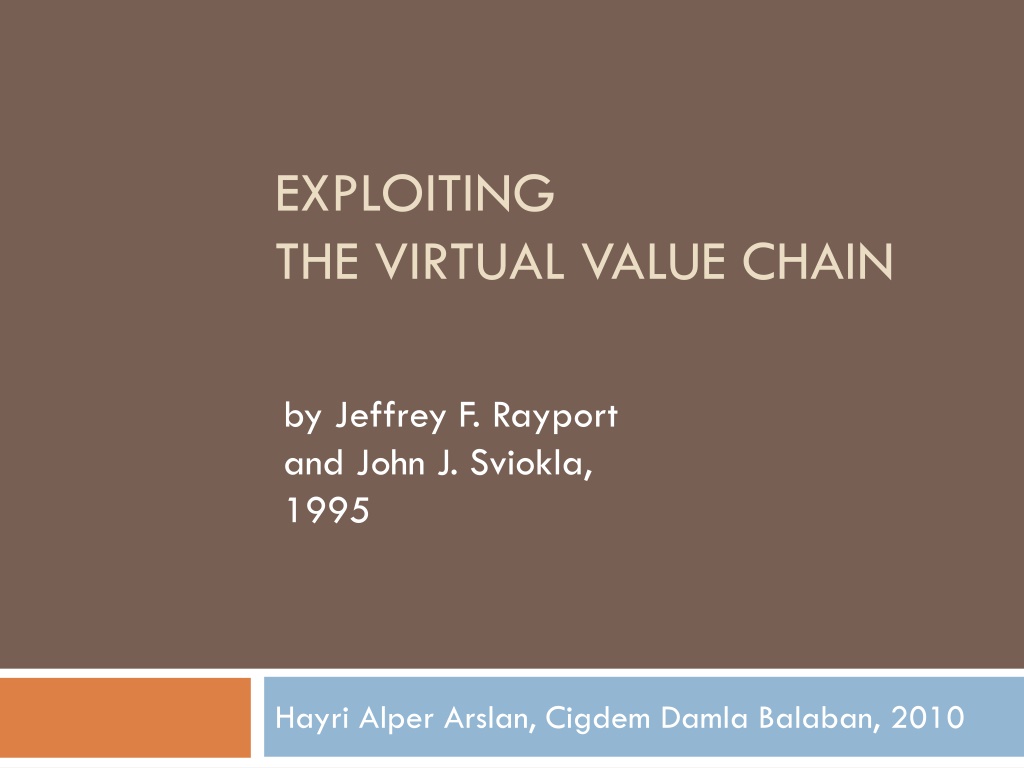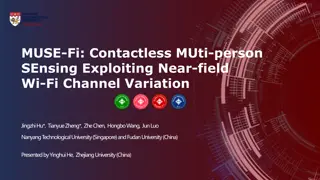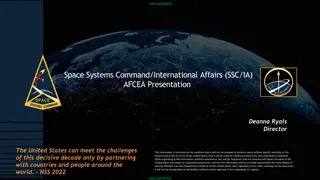EXPLOITING
Explore the concept of the virtual value chain and how it differs from traditional value chains. Learn how companies can extract value from information in the marketspace through stages like gathering, organizing, selecting, synthesizing, and distributing information. Understand the importance of adapting to a virtual world, mirroring capabilities, and building new customer relationships in the digital age.
Download Presentation
Please find below an Image/Link to download the presentation.
The content on the website is provided AS IS for your information and personal use only. It may not be sold, licensed, or shared on other websites without obtaining consent from the author. Download presentation by click this link. If you encounter any issues during the download, it is possible that the publisher has removed the file from their server.
Presentation Transcript
EXPLOITING THE VIRTUAL VALUE CHAIN by Jeffrey F. Rayport and John J. Sviokla, 1995 Hayri Alper Arslan, Cigdem Damla Balaban, 2010
Marketplace vs. marketspace Physical world vs. virtual world The value chain model treats information as a supporting element of the value-adding process, not as a source of value itself. FedEx
Virtual Value Chain To create and extract value with information, managers must turn to the virtual world of the marketspace. Virtual Value Chain Gathering information Organizing information Selecting information Synthesizing information Distributing information
Adapting to a virtual world Geffen How did they exploit the virtual value chain?
VVC vs. PVC The value chain of the marketspace mirrors that of the marketplace, but the value-adding steps are different in each realm. The economic logic of the two chains is different: The conventional understanding of the economies of scale and scope does not apply to the VCC. The two chains must be managed distinctly but also in concert.
3 stages of adopting to virtual world: Visibility Mirroring capabilities New customer relationships *Virtual value matrix
Visibility The information generated in the course of traditional operating activities helps managers see their physical value chains as an integrated system rather than as a set of discrete though related activities. Frito-Lay Integration of functional areas Information on suppliers, customers and competitors Combination of information from the each stage of value chain and field data
Mirroring capabilities Companies substitute virtual activities for physical activities: creation of a parallel value chain in the marketspace. Managers ask the question what are we doing now in the place and what could we do more efficiently and more effectively in the space? Dramatic low-cost approaches to delivering extraordinarily high-value results to the customers. Ford Motor Company: a global car with global appeal Boeing: a synthetic environment for testing designs
New Customer Relationships Once companies can manage value-adding activities across both chains, they can develop new customer relationships. Usage of World Wide Web Reinvention of new industries United Services Automobile Association (USAA) Through clever integration of the information harvested along the VVC and through a PVC that delivers goods and services, USAA creates new value for customers by serving a broader set of their needs.
The Value Matrix Each stage of the virtual value chain allows for many new extracts from the flow of information. Each extract could constitute a new product or service. An automobile manufacturer & value adding Lamborghini driving game & a new spin-off product Creation of digital assets through integration of place and space; Image Technology International
Image Technology International A digital approach to the capture, organization, selection, manipulation and distribution of photographic images: digital code is the raw material. Lower cost of creating digital photos Reusing the digital photos in several different ways A digital image database Considering how value is added in the information world, Image has invented the business model for the capture and display of images.
Implication for Management The law of digital assets New economies of scale New economies of scope Transaction-cost compression Rebalancing supply and demand
Questions Discuss the three stages of adapting to virtual world in detail. How is a virtual value chain established? Name the steps. What are new principles in managing virtual value chains in parallel to the physical value chains? 1. 2. 3.
Answers- Question 1 Visibility; the information generated in the course of traditional operating activities helps managers see their physical value chains as an integrated system rather than as a set of discrete though related activities. Mirroring Capabilites; companies substitute virtual activities for physical activities: creation of a parallel value chain in the marketspace. New Customer Relationships; once companies can manage value-adding activities across both chains, they can develop new ways to reach customers and open in new markets.
Answers- Question 2 There are five stages in the creation of value chain. The most important ingredient in establishment of value chain is information. Gathering information Organizing information Selecting information Synthesizing information Distributing information With these stages companies detect market opportunities and exploit them with new products and services in the virtual value chain
Answers- Question 3 The law of digital assets New economies of scale New economies of scope Transaction-cost compression Rebalancing supply and demand




